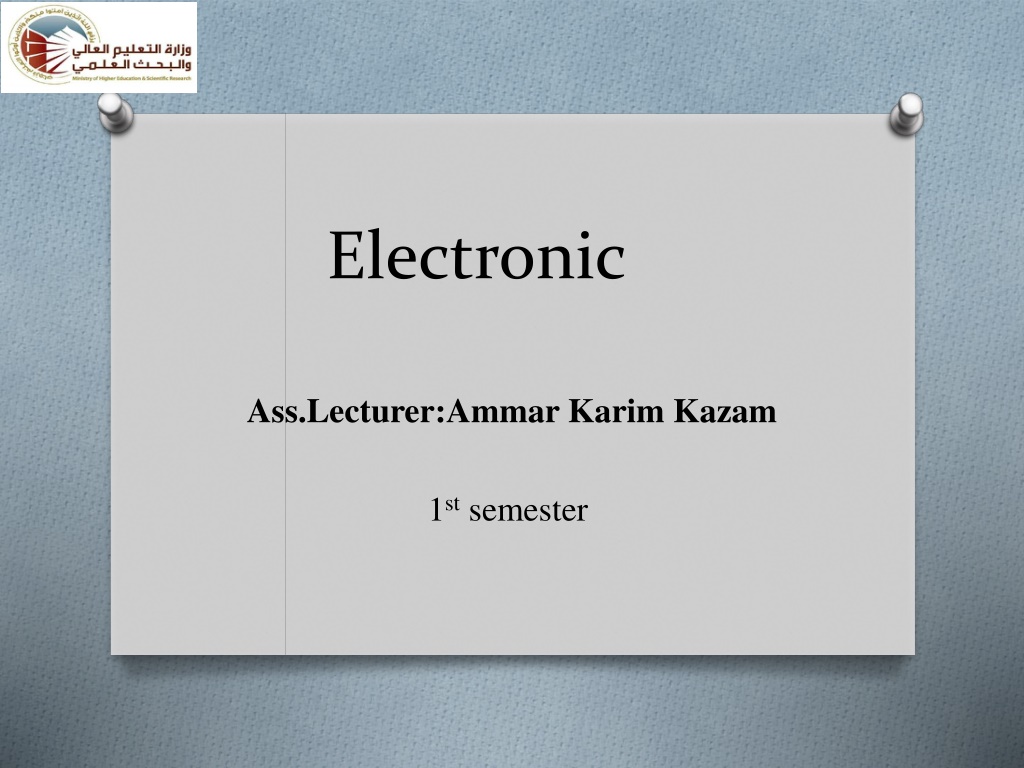
Understanding Zener Diodes: Operation and Applications
Explore the fundamentals of Zener diodes, their unique characteristics in the reverse-breakdown region, and their applications as voltage regulators. Learn about Zener impedance and how to calculate it. Discover the key features of Zener diodes and their role in providing stable reference voltages in electronic circuits.
Uploaded on | 0 Views
Download Presentation

Please find below an Image/Link to download the presentation.
The content on the website is provided AS IS for your information and personal use only. It may not be sold, licensed, or shared on other websites without obtaining consent from the author. If you encounter any issues during the download, it is possible that the publisher has removed the file from their server.
You are allowed to download the files provided on this website for personal or commercial use, subject to the condition that they are used lawfully. All files are the property of their respective owners.
The content on the website is provided AS IS for your information and personal use only. It may not be sold, licensed, or shared on other websites without obtaining consent from the author.
E N D
Presentation Transcript
Electronic Ass.Lecturer:Ammar Karim Kazam 1stsemester
Chapter 3 Special-Purpose Diodes 2
The Zener Diode A zener diode is a silicon pn junction device that is designed for operation in the reverse-breakdown region. When a diode reaches reverse breakdown, its voltage remains almost constant even though the current changes drastically, and this is key to the zener diode operation. A major application for zener diodes is as a type of voltage regulator for providing stable reference voltages to use in power supplies, voltmeters and other instruments. The symbol for a zener diode is shown in Figure 1. 3
Diode Cathode (K) Anode (A) The symbol for a zener diode is shown in Figure 1. 4
Forward Bias Zener diodes with breakdown voltages of less than approximately 5V operate in zener breakdown. Those with breakdown voltages greater than approximately 5V operate mostly in avalanche breakdown. Both types are called zener diodes. Zeners have breakdown voltages from less than 1V to more than 250V. As the reverse voltage (VR) increases, the reverse current (IR) remains extremely small up to the knee of the curve. Reverse current is also called zener current (Iz). At the knee point, the breakdown effect begins, and the internal zener resistance (ZZ) begins to decrease. The reverse current increase rapidly. The zener breakdown (VZ) voltage remains nearly constant. 5
Figure 3: Reverse characteristic of a zener diode. VZis usually specified at a value of the zener current known as the test current. The zener impedance, ZZ, is the ratio of a change in voltage in the breakdown region to the corresponding change in the current: ??= ?? ?? 6
The zener impedance, ZZ, is the ratio of a change in voltage in the breakdown region to the corresponding change in the current: ??= ?? ?? Example 1: What is the zener impedance if the zener diode voltage changes from 4.79 V to 4.94 V when the current changes from 5.00 mA to 10.0 mA? HW 7
Zener Diode Applications Zener Regulation with a Variable Input Voltage The zener diode can be used as a type of voltage regulator for providing stable reference voltages, as shown in Figure 5. The ability to keep reverse voltage constant across its terminal is the key feature of the zener diode. It maintains constant voltage over a range of reverse current values. A minimum reverse current IZKmust be maintained in order to keep diode in regulation mode. Voltage decreases drastically if the current is reduced below the knee of the curve. Above IZM, max current, the zener may get damaged permanently. 8
To illustrate regulation, let us use the ideal model of the 1N4740A zener diode (ignoring the zener resistance) in the circuit of Figure 6. Ideal model of IN4047A IZK = 0.25mA VZ = 10V PD(max) = 1W For the minimum zener current, the voltage across the 220 resistor is VR = IZKR = (0.25 mA)(220 ) = 55mV, Since VIN =VR+VZ, VIN(min) = VR + VZ = 55mV+10V= 10.055V For the maximum zener current, the voltage across the 220 resistor is VR = IZMR = (100 mA)(220 ) = 22V Therefore, VIN(max) = 22V+ 10V = 32V This shows that this zener diode can ideally regulate an input voltage from 10.055 to 32V and maintain an approximate 10V output. 10
Zener Regulation with variable load Figure 7 shows a zener voltage regulator with a variable load resistor across the terminals. The zener diode maintains a nearly constant voltage across RLas long as the zener current is greater than IZK and less than IZM. Figure 7: Zener regulation with a variable load. 11
When RL= (open cct), the load current is zero, and all of the current pass through the Zener diode. When RL is connected, the current is divided between the Zener diode and RL. The total current through R remains constant as long as the Zener is regulated. As RL decreases, IL increase, and IZ decreases. The Zener continues to regulate the voltage untilIZ reaches its minimum value. Now, the load current is maximum, and a full-load condition exists. 12
Example: Determine the minimum and the maximumloadcurrents for the Zener diode in Figure 8 will maintain regulation. What is the minimum value of RLthat can be used? VZ= 12 V, IZK= 1 mA and IZM= 50 mA. Assume an ideal Zener diode where ZZ= 0 and VZ remains a constant 12 V over the range of current values. Solution When IL=0, (RL= ), IZ=IZmax= IT I(Z(max))= IT= (VIN -VZ)/R= (24-12)/470= 25.5 mA If this value is less than 50 mA, RL can be removed without disturbing regulation. IL(min) = 0 A IL(max) occurs when IZ is minimum (IZ = IZK) IL(max) = IT Iz(min) = 25.5 mA 1 mA = 24.5 mA The minimum value of RL is R(L(min)) =VZ/I(L(max)) = 12 V/ 24.5 mA= 490 13 Regulation is maintained for any value of RL between 490 and infinity.
Zener Limiter Zener diodes can be used as limiters. Figure 9 shows three basic ways the limiting action of a Zener diode can be used. During the negative alternation, the Zener acts as a forward-biased diode and limits the negative voltage to-0.7V, as in part (A). When the Zener is turned around, as in part (B), the negative peak is limited by Zener action and the positive voltage is limited to +0.7V. Two back-to-back Zeners limit both peaks to the Zener voltage 0.7V, as shown in part (C). Figure 9: Basic Zener limiting action with a sinusoidal input voltage. 14
Varactor Diode A varactor diode is a special-purpose diode operated in reverse bias to form a voltage-controlled capacitor rather than traditional diodes. The applied voltage controls the capacitance and hence the resonant frequency. The width of the depletion region increases with reverse bias. These devices are commonly used in communication systems. Varactor diodes are also referred to as tuning diodes. Figure 10: The reverse-biased varactor diode acts as a variable capacitor. 15
Optical Diodes Optical Diodes In this section, three types of optoelectronic devices are introduced: the light- emitting diode, quantum dots, and the photodiode. The Light-Emitting Diode (LED) Light Emitting Diodes (LEDs), diodes can be made to emit light electroluminescence or sense light. When the device is forward-biased, electrons cross the pn junction from the n-type material and recombine with holes in the p-type material. The free electrons are in the conduction band and at a higher energy than the holes in the valence band. The difference in energy between the electrons and the holes corresponds to the energy of visible light. When recombination takes place, the recombining electrons release energy in the form of photons. 16
Conduction Electrons and Holes The emitted light tends to be monochromatic (one color) that depends on the band gap (and other factors). A large exposed surface area on one layer of the semiconductive material permits the photons to be emitted as visible light. This process, called electroluminescence, is illustrated in Figure 12. LEDs vary widely in size and brightness from small indicating lights and displays to high-intensity LEDs that are used in traffic signals, outdoor signs, and general illumination. Figure 11: Symbol for an LED. When forward-biased, it emits light. Figure12: Electroluminescence in a forward-biased LED. 17
The Photodiode The photodiode is a device that operates in reverse bias, as shown in Figure 13, where is I the reverse light current. The photodiodehas a small transparent window that allows light to strike the pn junction. A photodiode differs from a rectifier diode in that when its pn junction is exposed to light, the reverse current increases with the light intensity. When there is no incident light, the reverse current, I , is almost negligible and is called the dark current. Figure 13:Photodiode. 18
You are less likely to encounter several types of diodes as a technician. Among these are the laser diode, the Schottkydiode, the pin diode, the step-recovery diode, the tunnel diode, and the current regulator diode. The Laser Diode Laser light is monochromatic, meaning it consists of a single color, not a mixture of colors, compared to incoherent light, which consists of a wide band of wavelengths. The laser diode normally emits coherent light, whereas the LED emits incoherent light. Figure 14: Symbol for a Laser Diode. 19















